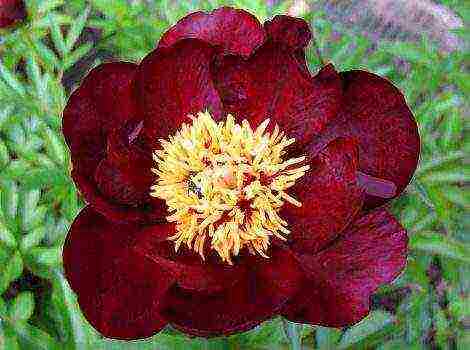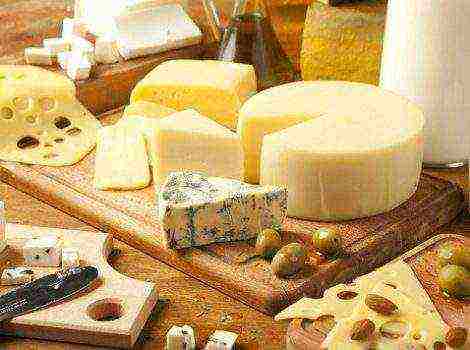Content [show]
According to gardeners, from stone fruit crops, plum is one of the most widespread and popular. Tasty and healthy fruits, as well as the unpretentiousness of trees in care, make it popular among amateur gardeners.
However, the climate of the Moscow region does not allow growing all currently existing varieties of plums. This is due to the fact that for many of them the flowering period often coincides with the last spring frost in this region. In this case, the fruit buds freeze out, which cannot but affect the harvest. We will present you the best varieties of plums for the Moscow region with photos and descriptions. Perhaps this will help you make the right choice when purchasing seedlings.
Features of growing plums in the Moscow region
Plum belongs to the Rosaceae family, which includes about two hundred and fifty species. Most of them are successfully cultivated in gardens and summer cottages. Home plum is grown in our country. The tree lives on average 20-25 years and grows up to twelve meters in height. The indisputable advantages of the plum include its ability to actively grow and develop on almost any soil.
The climate in the Moscow region is slightly milder than in the more northern or eastern regions. However, winter here is not only cold, but also with sharp temperature changes. That is why the selected variety must be cold-resistant.
Feature of self-fertile varieties
Today we will present you self-fertile varieties of plums for the Moscow region, but first, a few words about what the term “self-fertility” means. This is the ability of a plant to self-pollinate without the participation of bees and the neighborhood of trees of a related species.
Such trees, when cross-pollinated, give a significantly higher yield, since in this case both their own pollen and the pollen of neighboring trees are the pollinator. Under the influence of climatic conditions, partial self-fertility occurs, which is characterized by lower productivity.
Requirements for soil and planting site
Self-fertile varieties of plums for the Moscow region require special planting conditions for abundant and long fruiting. They should not be planted in low-lying areas where snow and water stagnate. The tree will feel more comfortable on sunny slopes, from which snow quickly melts, because then the root system of the tree does not suffer from excess moisture. If there is no natural hill on the site, create an artificial one.
After choosing a place for planting, it must be properly prepared.Usually this work is done in the fall. Despite the fact that this is a rather unpretentious plant - the plum is self-fertile, varieties for the Moscow region need to feed the soil. For 1 sq. m of soil, add 7 kg of humus, 30 grams of potassium salt and 50 grams of superphosphate. The minerals will dissolve, the soil will be significantly enriched, and young seedlings can be planted in spring.
The most delicious plum varieties for the Moscow region (self-fertile): Smolinka
Every gardener dreams of growing a big harvest on his site: fruits and berries should be tasty, aromatic and healthy. Today, such a result can be achieved by growing self-fertile plum varieties suitable for the Moscow region. The sweet fruits of Smolinka will please both adults and children.
The fruits have a regular shape, resembling an egg, the pulp is elastic, there are no pronounced depressions, the peritoneal suture is almost invisible. The variety has proven itself among gardeners of the Moscow region and today is considered one of the best for this region. Smolinka perfectly tolerates temperature extremes. A feature of the variety can be considered an early entry into fruiting and a high yield.
The fruits ripen in the second decade of August. With proper care, up to 23 kilograms of delicious and sweet fruits weighing up to 40 grams can be removed from the tree. They can be used both fresh and processed. Other features of the variety include:
- tree height (more than five meters);
- at the age of two, fruiting begins;
- when freezing, it freezes a little, but recovers very quickly;
- vaccinations are allowed;
- the crown is very dense, so the trees on the site take up too much space.
Hungarian Korneevskaya
This variety is known for its high sugar content, for which it received well-deserved recognition among gardeners of the Moscow region. The fruits are dark in color, from which excellent prunes are obtained. It is a self-fertile variety with very large dessert fruits. The bone is easily separated from the pulp.
The tree begins to bear fruit in 3-4 years. The disadvantage of this variety, of course, is the breaking of branches that cannot withstand the weight of the crop and the need to install props.
Zarechnaya early
Another self-fertile plum. Varieties for the Moscow region, as we have already said, should be distinguished by increased winter hardiness. This one fully meets this requirement. The fruits, painted in dark purple color, are oval in shape. They are colored deep purple.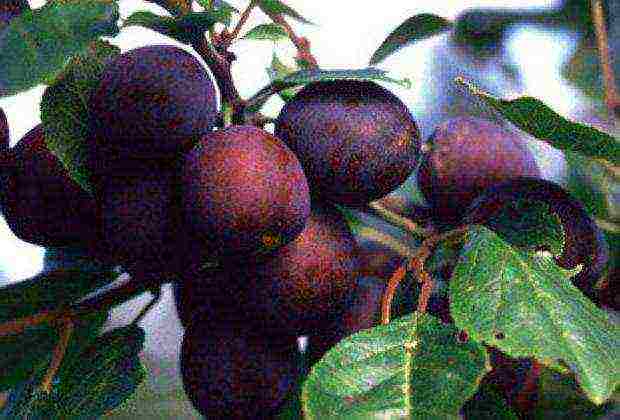
Plums are very large - their weight reaches 55 grams. Due to the fact that the seed is easily removed from the fruit, the variety is widely used for home preservation.
Advantages:
- high frost resistance;
- stable yield;
- early entry into fruiting (in the second year);
- sweet and sour taste with a pronounced aroma.
The disadvantages of this variety, gardeners include pinching in huge quantities, which negatively affects the harvest. Therefore, it is necessary to closely monitor and remove stepchildren.
Early
A wonderful self-fertile variety, which is very popular among gardeners in the Moscow region due to its high yield and large fruits (45 grams). They have a pleasant taste with a subtle sourness. The tree grows no more than 4.5 meters in height.
Blue bird
Today, the market is represented by many varieties of plums for the Moscow region. The best variety (self-fertile), according to gardeners, is the Blue Bird. Its fruits are large (up to 50 grams), oval in shape with a thin dark blue skin that has a light waxy coating.
The pulp is firm. The harvest ripens in mid-August. These plums are suitable for canning as they are easily pitted. The fruits ripen evenly, the variety is winter-hardy, having immunity to the most common stone fruit diseases: to polystygmosis, clotteroporosis and moniliosis. Subject to the rules of agricultural technology, the yield reaches 35 kilograms from one tree.
Medium-tall varieties - In memory of Timiryazev
If you are interested in self-fertile varieties of yellow plum for the Moscow region, we recommend that you pay attention to this variety, popular and beloved by many gardeners, which grows well and bears fruit not only in the Moscow region, but also in more northern regions.
It is a mid-late plum that yields until early September. In color and color, the fruits resemble apples. The skin is yellow, with a red spot on the side. The fruits are round, without a peritoneal suture. They have a pleasant fine-grained pulp with a delicate aroma and pleasant sourness. The indisputable merits include self-fertility.
Yakhontova
The best varieties of yellow plum for the Moscow region (self-fertile) in our article are represented by this variety. The tree grows up to five meters, it is not afraid of spring return frosts, which are often the reason for the death of flower buds in most fruit trees. Large and juicy sunny fruits (35 g), are distinguished by a bright and rich sweet and sour taste. The variety is high-yielding - up to fifty kilograms of plums can be removed from one tree.
Harvested from late August to mid-September. The tree easily tolerates dry days, is resistant to fungal and viral diseases. The only drawback: the fruits need urgent processing - they are not stored at all.
Mara
Today, in the vicinity of the capital, in many garden plots, plum grows well and bears fruit for the Moscow region. It is rather difficult to name the best self-fertile variety, because, firstly, there are a lot of them now, and secondly, in most cases, the choice depends on your taste preferences: someone loves only sweet fruits, someone must have sourness in their taste, some like dense pulp, others prefer more tender and juicy, etc.
Plum Mara tolerates rather harsh winters, has strong immunity to most plum diseases. The tree grows no more than three meters, has a beautiful crown in the shape of a ball, which needs formative pruning. The variety is early - the fruits ripen at the beginning of July and, what is remarkable, without falling off, they can hang on the branches until the beginning of August, without losing their taste.
The skin is colored deep yellow, the flesh is slightly lighter. The taste will delight lovers of sweet fruits. They are perfect for making jams and preserves.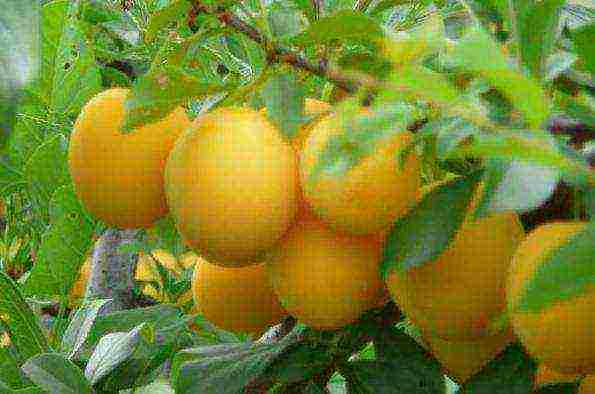
Korneevskaya
Self-fertile varieties of plums for the Moscow region often cause serious disputes between gardeners. For example, some believe that Korneevskaya has too long a period of entry into fruiting (up to 6 years), their opponents are sure that such a long wait for the harvest is more than justified by the high yield, which reaches 50 kilograms per tree. In addition, it has tasty, aromatic and juicy fruits. The obvious disadvantages of the variety include instability to some diseases of stone fruits.
Kolkhoz renklode
This self-fertile variety is well known to gardeners near Moscow. It is distinguished by stable high yields and frost resistance. Medium-sized fruits are covered with dark yellow skin. The pulp is sweet and juicy. Without timely and competent care, the yield of the tree decreases.
The best plum varieties for the Moscow region (self-fertile) undersized
This category includes primarily columnar varieties that do not grow above one and a half to two meters. They have a compact crown and are not too difficult to care for.
Imperial
This is one of the first columnar varieties of plum, which today is popular with gardeners in the Moscow region, thanks to its juicy and large fruits. The fruits are rounded in shape and weigh up to 55 grams. The skin is firm, reddish brown or purple. The pulp has a beautiful golden hue and a pleasant sweet taste with a slight sourness.
The variety is universal - the fruits can be used for making compotes, jams, preserves, as well as consumed fresh. The advantage of the variety is self-fertility and self-pollination.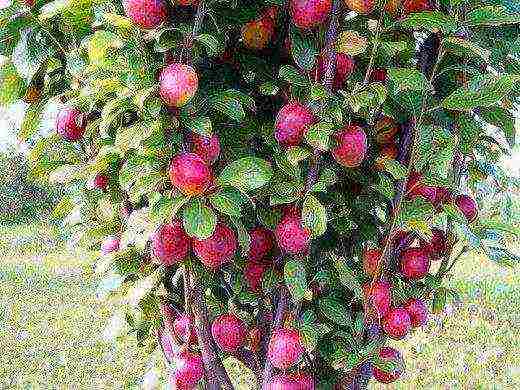
Oryol dream
Many summer residents believe that in recent years the best varieties of plums have been bred for the Moscow region. Self-fertile, low-growing plants give excellent yields and are very easy to care for. Indeed, the Oryol Dream is a variety that has recently appeared in gardens, but has already won many fans.
It has large, rounded fruits (up to 43 grams) of red color, with numerous subcutaneous specks. This is a table variety with an average yield, but at the same time it is highly resistant to many diseases and winter hardiness. One cannot but mention some of its shortcomings - the fibrous pulp and the difficult separation of the bone.
So, we have presented you the best self-fertile varieties of plums for the Moscow region. Which one to choose is up to you. We hope that you will be able to grow and reap a good harvest of these healthy and tasty fruits.
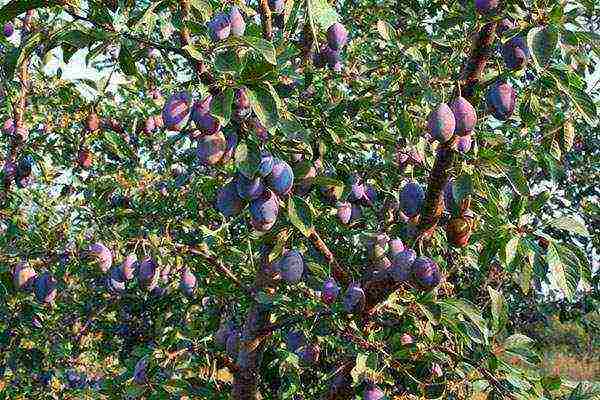 The plant belongs to the stone fruit genus. Plum for the Moscow region is the best sort of fruit tree for its unpretentiousness. Unlike apricots and peaches, plum initially grows in temperate latitudes and endures winter cooling. Gardeners are offered a variety of varieties based on long-term selection of different types of plums from China, Spain, America, and their multiple cross-pollination.
The plant belongs to the stone fruit genus. Plum for the Moscow region is the best sort of fruit tree for its unpretentiousness. Unlike apricots and peaches, plum initially grows in temperate latitudes and endures winter cooling. Gardeners are offered a variety of varieties based on long-term selection of different types of plums from China, Spain, America, and their multiple cross-pollination.
Plum characteristic
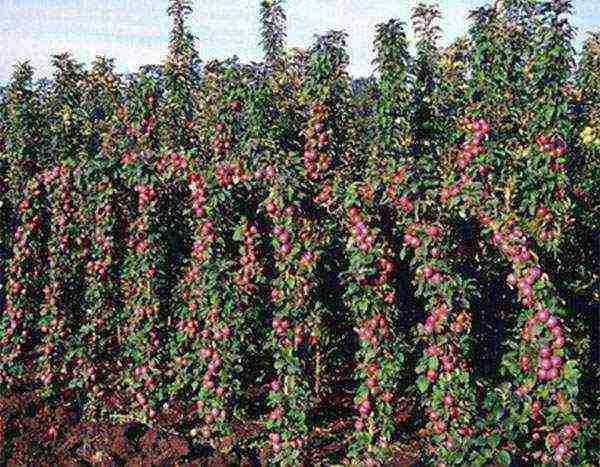 All plums represent a tree derived from a seed. Basically, plums grow up to 3-6 meters, have a rounded crown. Skeletal branches are located at an acute angle to the trunk, the shape of the tree depends on the variety. There are columnar plants - the result of natural mutation, fixed by selection. Compact and productive, they claim to be the best varieties of plums for the Moscow region.
All plums represent a tree derived from a seed. Basically, plums grow up to 3-6 meters, have a rounded crown. Skeletal branches are located at an acute angle to the trunk, the shape of the tree depends on the variety. There are columnar plants - the result of natural mutation, fixed by selection. Compact and productive, they claim to be the best varieties of plums for the Moscow region.
Plum fruits, depending on the variety, are green to dark purple in color. The size of the cream varies from 20 to 150 grams. There are self-fertile varieties, but any of them will give high yields when cross-pollinated. The harvest ripens in the Moscow region from July to mid-September, depending on the variety.
All plum varieties are divided according to their use:
- edible plums, distinguished by a pleasant taste, almost all of them are obtained as a result of selection;
- conditionally edible are the fruits of the wild plum, which have no market value;
- decorative plums are used in landscape design, their flowering, tree and leaf shape create a unique landscape.
Consider the best varieties of plums for the Moscow region, which are in demand among amateurs and professionals.
Early varieties of plums
In July and at the very beginning of August, early varieties will give a harvest of tasty fruits.
 The variety belongs to the domestic group, obtained by the breeders Kursakov. The tree is of medium height, compact, spherical in shape. The leaves are large, the buds extend from the shoot. The tree begins to bear fruit 4 years after planting. Annual flowering with high winter hardiness. The variety is resistant to typical plum diseases. Plum Zarechnaya early refers to self-infertile varieties, the pollinator can be Etude, Tambov beauty.
The variety belongs to the domestic group, obtained by the breeders Kursakov. The tree is of medium height, compact, spherical in shape. The leaves are large, the buds extend from the shoot. The tree begins to bear fruit 4 years after planting. Annual flowering with high winter hardiness. The variety is resistant to typical plum diseases. Plum Zarechnaya early refers to self-infertile varieties, the pollinator can be Etude, Tambov beauty.
The variety belongs to table varieties, has good transportability. Fruits weighing 35-60 grams have a taste of 4.5 points on a five-point scale, ripen at the same time in mid-July.
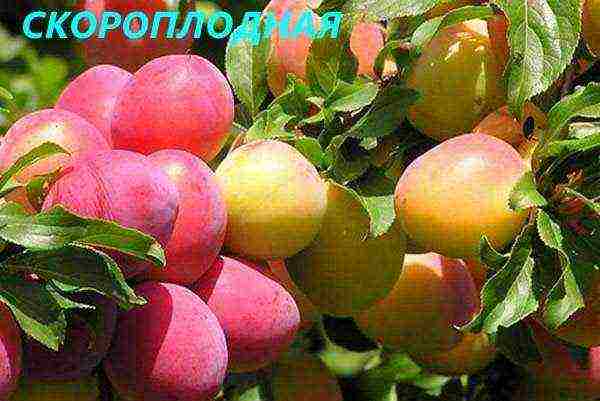 One of the earliest and most productive varieties, which bears fruit well even in the northern part of the Moscow region. The fruits are medium-sized, only 30 g, but the branches are strewn with multi-colored balls. The cream does not lose its taste after freezing, it is suitable for culinary processing. The variety begins to bear fruit the next year after planting. An adult tree will give 30 kg of delicious fruits. The tree can withstand -40 C, but it does not tolerate thaws well. Plum variety Skoroplodnaya is self-fertile, and is pollinated only by cherry plum hybrids. The plum variety Red Ball is suitable for pollination. This is due to early flowering. The height of the spherical tree is 2.5 meters, the hybrid is obtained from the American-Chinese variety Claymex, by pollination of Ussuriyskaya red.
One of the earliest and most productive varieties, which bears fruit well even in the northern part of the Moscow region. The fruits are medium-sized, only 30 g, but the branches are strewn with multi-colored balls. The cream does not lose its taste after freezing, it is suitable for culinary processing. The variety begins to bear fruit the next year after planting. An adult tree will give 30 kg of delicious fruits. The tree can withstand -40 C, but it does not tolerate thaws well. Plum variety Skoroplodnaya is self-fertile, and is pollinated only by cherry plum hybrids. The plum variety Red Ball is suitable for pollination. This is due to early flowering. The height of the spherical tree is 2.5 meters, the hybrid is obtained from the American-Chinese variety Claymex, by pollination of Ussuriyskaya red.
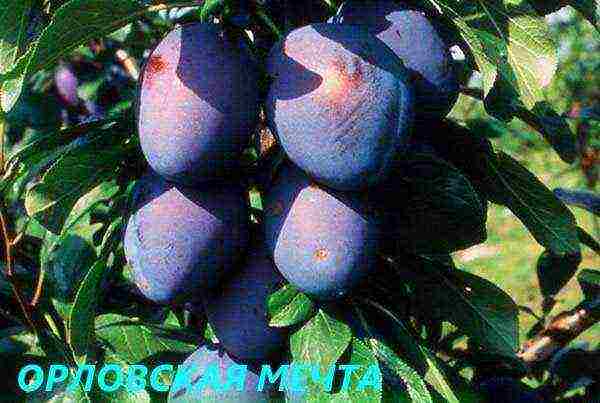 An early variety bred on the basis of the Chinese generation. The tree is not tall, 2.5 m tall, the crown is spreading, pyramidal.The leaf is light green, serrated, sharply pointed. The flowers are large, 3 pieces each, white. Fruits weighing 45 g, juicy, fibrous. Taste qualities are estimated at 4.4 points. The fruits of the Orlovskaya Mechta plum do not crack, do not fall, ripen in August.
An early variety bred on the basis of the Chinese generation. The tree is not tall, 2.5 m tall, the crown is spreading, pyramidal.The leaf is light green, serrated, sharply pointed. The flowers are large, 3 pieces each, white. Fruits weighing 45 g, juicy, fibrous. Taste qualities are estimated at 4.4 points. The fruits of the Orlovskaya Mechta plum do not crack, do not fall, ripen in August.
Fruiting occurs at the age of 3 years, the variety is resistant to perforated spotting, the winter hardiness of the roots and the ground part is high. With a large harvest, the fruits become smaller in weight.
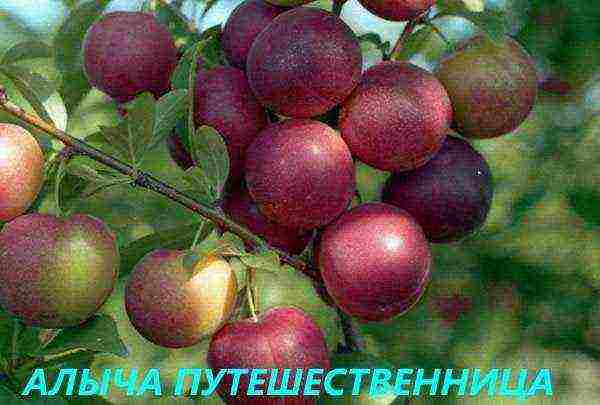 The variety belongs to the group "Russian plum", obtained by pollination of cherry plum Tavricheskaya Chinese plum Burbank. The tree is vigorous, 3 m in height, covered with early fruits of small size - 20-30 grams.
The variety belongs to the group "Russian plum", obtained by pollination of cherry plum Tavricheskaya Chinese plum Burbank. The tree is vigorous, 3 m in height, covered with early fruits of small size - 20-30 grams.
The advantages of the Traveler plum are:
- high winter hardiness;
- early maturation;
- resistance to fungal diseases;
- annual fruiting.
Disadvantages - self-infertility, with early flowering it is frozen by recurrent frosts.
Late and medium varieties of plums, the best for the Moscow region
 The Hungarian group of plums has a high sugar content, dark color, from which they get prunes, everyone's favorite dried product. The trees are tall, plums are harvested after litter. Plum Vengerka Korneevskaya is a self-fertile variety, with a plum weight of 130-140 grams. Dessert fruits, the pulp separates well from the seeds. Fruiting of the tree begins 3-4 years after planting. A feature of this variety is the breaking of branches under the weight of the harvest. Props required.
The Hungarian group of plums has a high sugar content, dark color, from which they get prunes, everyone's favorite dried product. The trees are tall, plums are harvested after litter. Plum Vengerka Korneevskaya is a self-fertile variety, with a plum weight of 130-140 grams. Dessert fruits, the pulp separates well from the seeds. Fruiting of the tree begins 3-4 years after planting. A feature of this variety is the breaking of branches under the weight of the harvest. Props required.
Hungarian requires careful adherence to the terms of preventive treatment against diseases and pests.
 The plum Smolinka, known in Central Russia, is like cultivation only in the southern part of the Moscow region. The oval-ovoid fruits weigh 35 grams. Dessert plum taste, the harvest is harvested in mid-August, up to 15-20 kg from one plum. The tree is fast-growing, fruiting occurs in 2-3 years, frost-resistant with rapid regeneration, grows up to 5.5 meters. The cultivar is cross-pollinated, the pollinator is Superearly and Opal. The branches are strewn with fruits in autumn; without props, they can break.
The plum Smolinka, known in Central Russia, is like cultivation only in the southern part of the Moscow region. The oval-ovoid fruits weigh 35 grams. Dessert plum taste, the harvest is harvested in mid-August, up to 15-20 kg from one plum. The tree is fast-growing, fruiting occurs in 2-3 years, frost-resistant with rapid regeneration, grows up to 5.5 meters. The cultivar is cross-pollinated, the pollinator is Superearly and Opal. The branches are strewn with fruits in autumn; without props, they can break.
 Small fruits weighing 22 grams of unique taste made the Pamyat Timiryazev plum a favorite of the gardens of the Moscow region, Central and Middle Volga regions. The fruits ripen in late August and early September. The crown of the tree is bushy, with branches lowered under the weight of the harvest.
Small fruits weighing 22 grams of unique taste made the Pamyat Timiryazev plum a favorite of the gardens of the Moscow region, Central and Middle Volga regions. The fruits ripen in late August and early September. The crown of the tree is bushy, with branches lowered under the weight of the harvest.
The variety is self-fertile with a high restorative ability when freezing. The advantage of Timiryazev's memory plum is its resistance to clasterosporium disease and fruit rot. The tree does not like drought, is moisture-loving, but is affected by ticks.
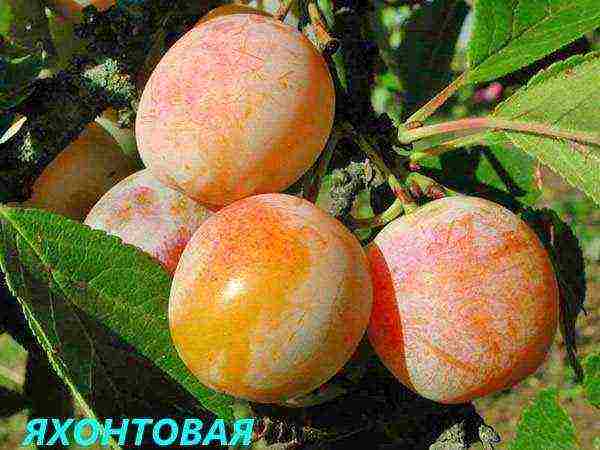 Yellow medium-sized fruits weighing 25-35 grams by autumn cover a tree with a height of 5.5 meters completely. Plum Yakhontovaya tolerates drought, frost-resistant, not afraid of recurrent frosts. The variety is partially self-fertile, even without a girlfriend every year it will present its owners with tender juicy fruits with a small bone.
Yellow medium-sized fruits weighing 25-35 grams by autumn cover a tree with a height of 5.5 meters completely. Plum Yakhontovaya tolerates drought, frost-resistant, not afraid of recurrent frosts. The variety is partially self-fertile, even without a girlfriend every year it will present its owners with tender juicy fruits with a small bone.
Plum fruiting occurs at 3 years, and in the fifth you can get 50 kg of sun-filled fruits. But this is subject to the presence of a plum in the neighborhood Vengerka Moscow or Skorospelka red.
There is a doubt whether it is worth planting such a tall tree in the country. But there is also a way out - to buy a Yakhontova plum sapling on the dwarf rootstock of Alexy plum or Felt cherry.
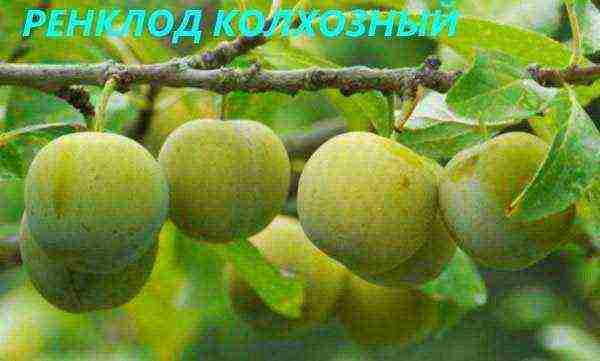 An old variety of the domestic group with Italian roots and excellent winter hardiness. The tree is up to 3 meters high, rounded - spreading in shape. Plum Renklod kolkhoz has a small yellow-green cream. Plum belongs to table varieties, well canned. The variety was created by Michurin, crossing Ternoslivu and Green Renklode. Fruiting begins at 4-5 years of age and grows gradually. An eight-year-old tree will give up to 18 kg of cream, and at 11 years old - already half a centner. Only you need to collect the fruits quickly, otherwise they will crumble.
An old variety of the domestic group with Italian roots and excellent winter hardiness. The tree is up to 3 meters high, rounded - spreading in shape. Plum Renklod kolkhoz has a small yellow-green cream. Plum belongs to table varieties, well canned. The variety was created by Michurin, crossing Ternoslivu and Green Renklode. Fruiting begins at 4-5 years of age and grows gradually. An eight-year-old tree will give up to 18 kg of cream, and at 11 years old - already half a centner. Only you need to collect the fruits quickly, otherwise they will crumble.
Advantages of the collective farm Renklode plum:
- exceptional frost resistance and recovery after an abnormally cold winter;
- the trunk of the tree is not susceptible to frost breaks.
Plum requires a pollinator, which cannot be derived from Chinese varieties.
 The full name of the variety is Egg Blue Plum. The tree is tall, up to 6 meters, capable of bearing fruit for 30 years. Its main advantages are self-fertility and winter hardiness. You should not expect a particularly large harvest from this variety, up to 12 kg of tasty fruits annually, no matter what, it will give. The weight of the fragrant sweet berry is 35 grams. Begins fruiting in 5-6 years. Withstands 35 degrees of frost without kidney damage. The tree can become a decoration of the local area. The crop is stretched, and hangs on the branches for a long time.
The full name of the variety is Egg Blue Plum. The tree is tall, up to 6 meters, capable of bearing fruit for 30 years. Its main advantages are self-fertility and winter hardiness. You should not expect a particularly large harvest from this variety, up to 12 kg of tasty fruits annually, no matter what, it will give. The weight of the fragrant sweet berry is 35 grams. Begins fruiting in 5-6 years. Withstands 35 degrees of frost without kidney damage. The tree can become a decoration of the local area. The crop is stretched, and hangs on the branches for a long time.
 Before you is a columnar plum in bloom. Imagine her, strewn with fruits weighing 60 grams. Interestingly, the columnar varieties are a gift of nature, a genetic malfunction. The breeders noticed the unusual shape of the tree and fixed it. As a result, varieties of columnar fruit trees have emerged, including plums.
Before you is a columnar plum in bloom. Imagine her, strewn with fruits weighing 60 grams. Interestingly, the columnar varieties are a gift of nature, a genetic malfunction. The breeders noticed the unusual shape of the tree and fixed it. As a result, varieties of columnar fruit trees have emerged, including plums.
The peculiarity of such a tree is the absence of the usual skeletal branches, and fruit branches and lances are formed close to the trunk. At the same time, the yield of trees of this shape surpasses ordinary trunks, and very little space is needed for the development of such a tree.
 Imperial columnar plum is fast-growing, the first harvest forms in 2 years, at 17 the fruiting ends, and the decorative effect remains for several more years. Imperial fruits are large, 60 grams, and very tasty.
Imperial columnar plum is fast-growing, the first harvest forms in 2 years, at 17 the fruiting ends, and the decorative effect remains for several more years. Imperial fruits are large, 60 grams, and very tasty.
The tree reaches a height of 1.5-2 meters, does not need pruning, but requires support, otherwise it will bend under the weight of the crop. Columns need protection in winter at any age, especially seedlings.
It is a responsible matter to choose a variety of plums for a summer residence. It should be taken into account that the tree shows the best properties when agricultural technology is followed.
Video about columnar drain
The most popular varieties of plums for the middle band
In this article, you can familiarize yourself with the photos, names and descriptions of varieties of plums grown in the Moscow region and central Russia.
Ripe red (Ripe pink, Red ordinary)
The most popular variety of plums in the average Russian region. Trees of medium development, with an oval-rounded medium dense crown. The variety is winter-hardy, sufficiently drought-resistant and productive. It starts bearing fruit from the 4th to 5th year after grafting and from the 5th to 6th year when it is planted with root suckers, with which it mainly reproduces. With the entry into fruiting, the yield increases rapidly. Early flowering. In the period of increasing yields (5-10 years), it gives an average of 2-10 kg of fruits per tree, and during the period of the highest yields (10-25 years) - 10-30 kg, some trees give 40-50 kg of fruit.
This variety of plums, recommended for the Moscow region, has medium-sized fruits (average weight 15 g), oval-ovate, with a dark red color - solid or in the form of densely scattered small dots and a light bloom ("frost"). The pulp is yellow-green, good sweet, with mild acidity, taste. The stone is large, flat, oval-ovoid, weight 1.4 g.
The beginning of ripening is 5-10 August, mass harvesting is 10-20 August, the end of harvesting is 20-25 August. Transportability is good. Consumption - fresh, for technical processing and homemade products.
With a lack of moisture or overripe, the fruits crumble heavily. Although the variety is relatively drought-resistant, high yields of the best commercial quality of fruits are obtained on medium-heavy soils, well fertilized and irrigated.
Garden tern (Tern Tsaregradskiy, Tern No. 2)
A tree or shrub of strong development, with an oval-rounded, highly branched crown. Differs in high winter hardiness, drought resistance and good productivity. Early flowering. Fruits are medium, weighing about 10 g, round, blue-violet, sour, with great astringency. Fruits ripen in mid-September.
The consumption of fruits in all varieties of blackthorn mainly for household procurement and technical processing.
Seedlings of garden thorns (no. 2) are good rootstocks for plums, and the root suckers, with which it mainly reproduces, can go to shelter plantings.
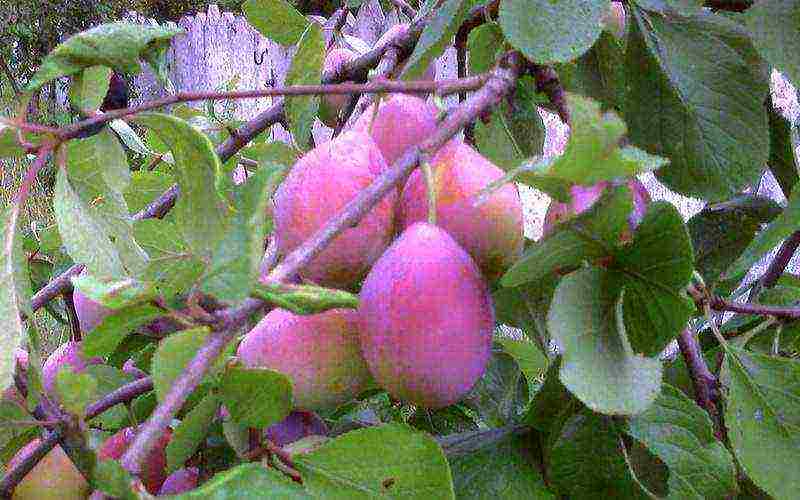
Plum variety "Pear-shaped" in the photo
Pear-shaped
The tree is of medium development, with a pyramidal, non-spreading crown. Winter hardiness is good - higher than that of the varieties Ochakovskaya Belaya (mother), Renklods Liya and Lenya, etc. The yield is high, annual. Early flowering.
As you can see in the photo, this one of the best varieties of plums for the Moscow region has large fruits, about 30 g in weight, oval-pear-shaped, with a red-violet integumentary, almost solid color, through which in some places the yellow-green basic color of the skin is visible:
The pulp is violet-yellow, juicy, soft, sweet, with mild acidity, excellent taste, dessert quality. The stone is medium, oval, weighing 0.9 g, well separated from the pulp. Fruit ripening is average - in the second half of August. The main purpose of the variety is dessert. Zoned in all the middle lane.
Below are a few more collections of photos and descriptions of plum varieties recommended for the Moscow region and central Russia.
What kind of plum is better to plant in the suburbs
Volga Ternoslum
In a number of varieties or varieties of local origin, it is found in gardens of the middle lane. The best of them were selected: Ternosliv late (No. 1), Ternosliv early (No. 2), Ternosliv Kuybyshevskaya (No. 6), Ternosliv Syzranskaya (No. 8), etc.
Ternoslum No. 1 (late)
A tree or shrub of strong development with a fairly dense, upright, oval-rounded crown. The variety is winter-hardy, drought-resistant, with good productivity. It begins to bear fruit in the 4th - 5th year after planting by root suckers, with which the variety mainly reproduces. Early flowering. The trees of this one of the best varieties of plums for the Moscow region in the period of the greatest harvests (11-25 years) yield 8-25 kg per tree, and from individual trees - 30-40 kg.
Fruits are small, oval-round, weighing 9-10 g, dark purple, sweet and sour, with low astringency, taste. Pickup time is the first half of September.
Early ternosplum (No. 2)
The tree is of medium development, with a straight-growing oval-rounded medium-dense crown, winter hardiness is slightly lower than the previous variety, the yield is high. Begins fruiting in the 4th-5th year. Early flowering. At the time of full fruiting (12-25 years) yields 10-25 kg per tree, individual trees can produce up to 30-40 kg.
Fruits are not large, weighing 10-12 g, almost round, black-purple, with a thick bloom. Fruit picking - mid-August. The taste is sweet and sour, without astringency, good.
Ternoslum Kuibyshevskaya (No. 6)
The tree is not tall (up to 2.5-3 m) with a rounded, wide-spreading, rather dense crown. This variety of plums for central Russia is winter-hardy and drought-resistant. Medium resistant to gum flow. The yield is high, with a rapid increase in the first years of fruiting, the annual flowering is early. At the time of full fruiting, it gives an average of 15-20 kg per tree, and individual trees - 30-40 kg or more.
Fruits are small (weighing 13-14 g), round, dark blue, with a medium waxy bloom. Their pulp is light yellow, juicy, sweet and sour, with astringency, taste. The bone is not lagging behind. Fruit picking - in the middle of September.
Ternoslum Syzranskaya (No. 8)
By morphological and biological characteristics, it is very close to the thorny plum of Kuibyshevskaya (No. 6), differs from it in a slightly lower yield, smaller fruit size, and their earlier ripening.
Fruits of all sorts of hernose plum are mainly used for technical processing and home harvesting. Early plum (No. 2) is more suitable for fresh consumption.
The root system of all varieties of thorny plums lies deep in the soil, which makes it difficult to dig up offspring for reproduction. This is the variety of plums, which is better to overexpose in the nursery before planting in the garden, since their lateral roots are poorly developed.
Despite the drought resistance of certain varieties of thorns, under irrigation they give 1.5-2 times greater yields and better marketable fruit quality, especially Kuibyshevskaya ternoslum (No. b) and Syzran ternoslums (No. 8).
Look at the photos of the best varieties of plums, the description of which is given on this page:
The most delicious varieties of plums for the Moscow region and the middle zone
Blue Volga
The trees are vigorous, with an oval-rounded crown, medium winter hardiness and good productivity. Begin to bear fruit from 4-5 years. In the period of increasing yields (5-10 years) it gives from 2 to 10 kg of fruits per tree, and during the period of the highest yields (10-20 years) - 10-20 kg, maximum - 35-40 kg per tree. Early flowering.
Fruits are medium, sometimes small (average weight 15 g), oval, dark purple, with a strong light bloom. The pulp is light green, good (better early ripening red) sweet-sour taste. The stone is medium, weight 1.2 g.
The beginning of fruit ripening - in late August - early September, mass harvest - in mid-September, the end of harvest - the last days of September. When describing this variety of plums for the Moscow region, it is especially worth noting the high transportability of the fruits. Consumption - fresh, for technical processing and homemade products.
Garden sloe
In a number of varieties or varieties, it is bred throughout the Moscow region. The best of them were selected - Large-fruited thorn (No. 1), Tern tart (No. 2), etc.

Plum variety "Tern large-fruited (Tern No. 1)" in the photo
Large-fruited blackthorn (Blackthorn No. 1)
It grows as a tree or shrub of medium height with a spreading crown and dark green glossy leaves. The variety is winter-hardy, but less tart than Tern (No. 2); in some winters there are burns on trunks and branches, drought-resistant and fruitful. Begins fruiting in the 2-3rd year after planting by two-year offspring. Medium early flowering. In the period of full harvests (10-20 years) it gives 15-25 kg of fruit per tree, and from individual trees up to 30-40 kg.
Pay attention to the photo - this variety of plums for the middle lane has large fruits (for the thorn group), weighing 12-14 g, round, slightly flattened, dark blue, with a thick light gray bloom, sourish, with astringency:
The beginning of fruit ripening is the end of August - the beginning of September, and the mass harvest is in the second half of September. The stone is medium - 0.65 g in weight.
Renclaude Leah
Trees of moderate development with a broom-shaped crown. Medium-hardy, high-yielding and fast-growing. They begin to bear fruit from the 4th year after vaccination and from the 5th to 6th year during offspring reproduction. Medium early flowering. In the period of increasing yields (6-10 years), it produces up to 8 kg of fruits per tree, in the period of the highest yields (11-20 years) on average 8-30 kg.
Fruits are medium or small (weight 12-13 g), round, light yellow, with a thick white bloom, excellent sweet, slightly acidic taste. The stone is small, oval, poorly separable, weight 0.95 g.
Ripening of this one of the most delicious varieties of plums for the Moscow region in late August - early September, mass harvest - in mid-September. Consumption - fresh and for technical processing.
Renklode Lenya
A tree of moderate growth, with a broadly spreading, rounded crown. In the conditions of the region, it is a medium-hardy, high-yielding and early-growing variety. This is one of those plum varieties that can be planted with offspring. It starts bearing fruit from the 4th year after grafting and from the 5th to 6th year when propagated by offspring. Medium early flowering. In the period of increasing yields (6-10 years) it gives 1-10 kg of fruits per tree, in the period of the highest yields (10-20 years) —10-25 kg, some trees yield up to 30-35 kg.
Fruits are medium or small (weight 12-13 g), round, yellow-green, with a white waxy coating, excellent sweet, with a little acid taste. One of the best dessert varieties. The stone is small, slightly detachable, weight 1 g.
The beginning of ripening - late - August - early September, mass eats - in mid-September. Can go for technical processing.
Next, you will find out what other varieties of plums are better to plant in the Moscow region.
What varieties of plums are better to plant in the suburbs
October Hungarian
Medium-sized tree with an oval-rounded crown. Medium-hardy, high-yielding and fast-growing.Begins to bear fruit from the 4th year after vaccination and from 5-6 years when propagated by offspring. Early flowering. During the period of increasing yields (6-10 years) it gives up to 8 kg of fruits per tree, during the period of the highest yields (11-25 years) - 8-30 kg, from individual trees up to 35-40 kg.
This variety of plums, recommended for the Moscow region, has medium or small fruits (average weight 12 g), oval, light blue, with a bloom, juicy, good sweet-sour taste. The stone is medium, weight 0.91 g. Late variety. The beginning of ripening is mid-September, the mass harvest is at the beginning of October. Transportability is good. Consumption - fresh and for technical processing.
Kolkhoz renklode
Medium-sized tree, with a round, medium-dense, well-leafy crown. The variety is medium-hardy, high-yielding and fast-growing. Begins fruiting in the 4th-5th year.
Fruits are medium or small (10-12 g), round, yellow-green, with a grayish bloom, juicy, sweet, with mild acid taste. This one of the most delicious varieties of plums is considered a dessert. The stone is small, broadly oval. Ripening of fruits - in late August - early September.

Plum grade "Renclode of thorns" in the photo
Renclode of thorns
The tree is medium-sized, low, with a dense spreading crown. Average winter hardiness; the yield is good.
As you can see in the photo, this variety of plums, recommended for the Moscow region, has medium-sized, round, black-purple fruits, with dense pulp, pleasant sweetness with a weak acidity and astringency of taste. The stone is small, well behind the pulp.
Ripens in early September. Consumption - fresh and for technical processing. Recommended for growing in the middle lane.
The most productive varieties of plums for the middle lane
Dark girl
The tree is vigorous, with an elongated-oval, medium-dense, non-spreading crown. The showering is good. The variety is quite winter hardy. The yield is high, annual, with a rapid increase over the years.
The fruits are large, weighing about 20 g, rounded, with an even surface. The name of this plum variety is due to the dark purple color of its fruits. The pulp is yellow-green, juicy, soft, sweet and sour, good taste. The stone is medium, lagging behind the pulp, weight 0.75 g. Fruit picking time is the second half of August. Consumption - fresh and for technical processing. Recommended for growing in the middle lane.
Success
The tree is vigorous, with an oval-rounded, medium-dense, non-spreading crown. The deposition is thick. Medium early flowering. The trees are hardy. This is one of the most productive varieties of plums for the middle lane: at the first fruiting, it gives 1.2 kg of fruit, and at the fifth - about 25 kg.
Fruits are medium, weighing about 18 g, roundish, dark purple. The pulp is yellow-green, juicy, medium-dense, sweet and sour, very good taste. The stone is medium, weight 0.8 g, lagging behind the pulp. Pick-up time is the second half of August. The main purpose of the variety is dessert. It can also go for technical processing. Recommended for growing in the middle lane.
Volga beauty
A tree of strong development, with an oval-rounded, medium spreading, well-leafy crown. Winter hardiness, like that of Skorospelka red. Early flowering. The yield is high, annual.
The fruits are large, weighing 34 g, oval-rounded, somewhat narrowed towards the base, red-violet, beautiful. The pulp is orange-yellow, juicy, soft, sweet, with mild acid, very good taste (better than the early ripening red) The stone is large, weight 1.7 g, well lagging. Ripening of this fruitful variety of plums is early - in the first half of August. Dessert variety, can also go for technical processing.
The best varieties of plums for the Moscow region (with photo)
Renklod Kuibyshevsky
The tree is vigorous, with a rounded, broadly spreading, medium-dense crown. Winter hardy. The variety is early-growing, begins to bear fruit in the 3rd year. Medium early flowering. The yield is high, annual.
Fruits are large, weighing 25 g, round, green-yellow with a waxy bloom (type Green Renklode). The pulp is yellow-greenish, juicy, soft, sweet and sour, very good taste. In this variety of plums, recommended for the middle lane, the stone lags well behind the pulp. Ripening - in the first half of September. The main purpose of the variety is dessert, it is also good for technical processing. Zoned in all zones of the region.
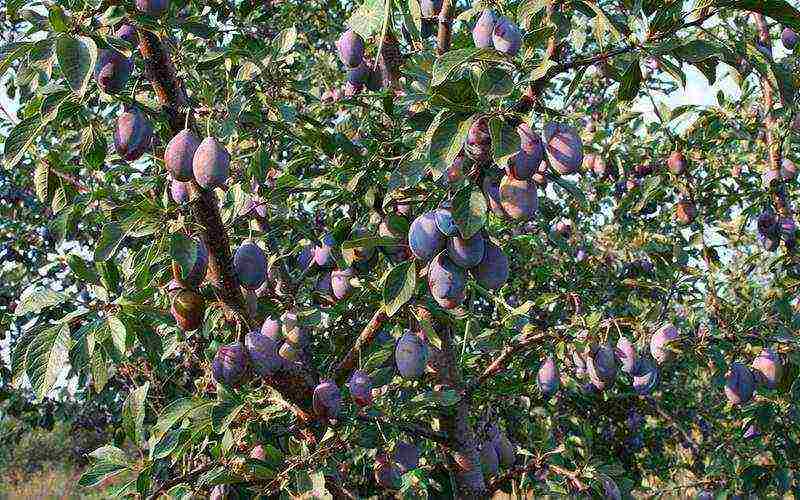
Plum variety "Hungarian Volzhskaya" in the photo
Volga Hungarian
The tree is vigorous, with an oval, medium spreading crown. The winter hardiness of the variety is not lower than Skorospelka red and Ternoslivy No. 2. It begins to bear fruit in the 4th year after grafting. The yield is high, annual, with a rapid increase over the years: in the 5-7th years of fruiting, the own-rooted mother tree yielded up to 40 kg. Medium early flowering, together with varieties of early ripening red, October Hungarian.
Look at the photo - this one of the best varieties of plums has large fruits - up to 27 g, oval, dark purple, with a medium thick waxy bloom:
The pulp of the fruit is yellow-green, soft, juicy, sweet and sour, excellent taste. The stone is oval, weighing about 1 g, lagging behind the pulp, which the parents do not have. Fruit ripening - the second half of August. It is consumed fresh as a dessert variety; can be used for technical processing: dough, jam, compotes, etc. Recommended for growing in the middle lane.
Renclode Volgo-Don
The tree is vigorous, with an elongated-oval, medium-dense, non-spreading crown. The shoots are thick. High winter hardiness - not lower than the local Ternosliva No. 1 or Skorospelka red. The variety is drought-resistant. Resistant to gum flow. The yield of this one of the best varieties of plums for the middle lane is very high, annual, higher than the yield of yellow rennlode, Lia rennlode, Ochakovskaya white and a number of other varieties: in the fifth or sixth years of fruiting, the native rooted mother tree yielded up to 30 kg of fruit. Medium early flowering.
The fruits are large, weighing about 30 g, almost round, yellow-green, with a thick waxy bloom. Largest - aligned. The pulp is juicy, light yellow, soft, with a good sweet and sour taste. The stone is medium, oval, about 1 g in weight, almost lagging behind the pulp. Fruit ripening is average - in the second half of August. It is used as a dessert, it can also be used for technical processing. Recommended for growing in the middle lane.
Here are photos of plum varieties, whose names are given above:
What other varieties of plum are
Striker
The tree is vigorous, with an oval-rounded medium-dense crown. Shoots are not thick. Winter hardiness is high, not lower than that of Ternosliva No. 1 and Skorospelka red. Resistant to gum flow. The yield of the variety is high, annual. Begins fruiting in the 4th - 5th year after grafting in the nursery. Own-rooted mother tree at the age of 12-13 years, in the 8-9th year of fruiting yielded 25-35 kg of fruit. Medium early flowering.
The fruits of this one of the best varieties of plums are large, weighing about 25 g, light yellow, with a medium waxy bloom, oval-round, and have a beautiful appearance. The pulp is light yellow, soft, juicy, with a good sweet-sour taste. The stone is medium, oval, 0.9 g, lagging behind the pulp. The picking time is medium late - in the first half of September. A versatile variety, but primarily used as a dessert. This is one of those plum varieties that are best planted in the Moscow region.

Plum variety "Mirnaya" in the photo
Peaceful
The tree is vigorous, with a flat-round, medium-spreading crown. In terms of winter hardiness, it is not lower than Skorospelka red and Ternoslivka Volzhskaya No. 1. The resistance of fruit buds against winter frosts and flowers against spring frosts is higher than that of Skorospelka red and other varieties. The yield is high, annual. It begins to bear fruit in the 4th-5th year after grafting in the nursery, and when grafted by cuttings into the crown of adult trees - at the 2nd-3rd year.Early flowering, simultaneously with Skorospelka red and Hungarian October.
As you can see in the photo, this variety of plums, recommended for the Moscow region, has large fruits, with an average weight of about 30 g, dark purple, with a thick waxy bloom, almost round:
The pulp is yellow-green, soft, juicy, sweet and sour, excellent taste. The stone is medium, weighing 1.3 g, lagging behind the pulp. Fruits ripen early - in mid-August. The best dessert variety; can also go to technical processing.
friendship
The tree is vigorous, with a rounded medium spreading crown. High winter hardiness - not lower than Ternosliva No. 6 (mother) and other forms of Ternosliva. The variety is fast-growing and fruitful. The grafted seedlings bear fruit in the 4th-5th year. Early flowering, simultaneously with varieties of early ripening red, thorny plums No. 1 and No. 6.
The fruits are large, with an average weight of about 27 g, dark blue, with a light waxy bloom, almost round, have a beautiful appearance. The pulp is yellow-green, soft, juicy, sweet and sour, very good taste. The stone is medium, weighing 0.9 g, lagging behind the pulp. The average time of fruit picking is in the second half of August. In some years, the abundant ovary of the fruits of this tasty variety of plums necessitates their partial thinning. Periodic feeding with full mineral fertilizer is required.
Plum is a stone fruit crop, the importance of which for Russian gardens can hardly be overestimated. A rare summer resident will refuse to plant it on his site. Nurseries today offer a huge assortment of seedlings of all kinds. In the article, we will tell you how not to get lost in this variety and choose the best self-fertile varieties of plums for the Moscow region and other regions of the Central region of Russia.
Mistakes when choosing a variety: what to look for
Mistake # 1. The choice of a non-zoned variety.
Plum is a genetically thermophilic and light-demanding crop. This is not surprising, because the geographical center of origin of this plant was the regions of Asia Minor and the Balkan Peninsula. Thousands of years of cultivation of plums in more northern latitudes, although it made it possible to adapt it to the harsh climatic conditions, nature often takes its own: not every tree can withstand the Russian winter.
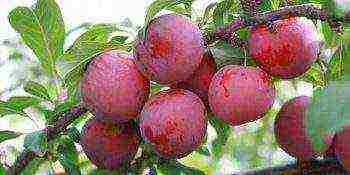
The first criterion for choosing a plum variety for the Moscow region is an indicator of winter hardiness.
Mistake # 2. Ignoring the indicator of self-fertility.
Sometimes it happens like this: both frost resistance is at the level, and the flowering is plentiful, and the yield is almost zero. The reason lies in the self-sterility of many varieties. The fact is that the plum is a cross-pollinated plant. For the formation of ovaries, it is necessary that the pollen on the stigma of the pistil comes from another tree. But in a small area, it is difficult to provide plants with cross-pollination. Hence follows the second criterion - the high self-fertility of the variety.
Mistake number 3. Ignoring the indicator of early maturity.
In the Middle lane, the summer is relatively short. In the Moscow region in May, the probability of recurrent frosts is still preserved, and by mid-September it is already quite cold. Therefore, varieties with a long growing season are of little use - they simply do not have time to ripen. This is the case, for example, with the excellent large-fruited President plum. With a high winter hardiness of wood and flower buds, in some years it cannot give a normal harvest due to the early cold weather. This means that the third important point when choosing a variety for the Moscow region is early maturity.
Other criteria for choosing a variety
Although they are not of vital importance, they can become decisive. Important nuances when choosing a seedling include:
- early maturity;
- the size of the tree;
- sizes, keeping quality and dessert qualities of fruits.
Comparative characteristics of varieties
To find out which varieties of domestic plums are zoned in the Moscow region, just look at the Rosreestr website. The Moscow region belongs to the region of admission No. 3. The list contains 18 varieties. All of them have good winter hardiness, but differ in other indicators.
Early ripe varieties of plums
These plums give off the harvest by mid-August.
| Variety | Early maturity | Self-fertility | Fruit quality |
| Volga beauty | Fertile for 4-5 years | No | On average - 34 g. The skin is red-violet, the pulp is orange, fibrous, with a good dessert taste. Semi-detachable bone. |
| Crooman | Fertile for 3-4 years | Partial | On average - 35 g. Skin color - dark blue, yellow pulp, juicy, tasting rating - 4.7. |
| Early ripening red | Fertile for 3-4 years | Partial | On average - 15 g. The skin is pink-red, the pulp is yellow, not very juicy, with a mediocre taste. |
| Blue gift | Fertile for 5 years | Partial | On average - 14 g. One-dimensional, violet-blue, with greenish-yellow, fibrous juicy pulp. Score - 3.8. |
| Yakhontova | Fertile for 3-4 years | Partial | On average - 30 g. The skin is yellow, the pulp is yellow, juicy, tender. Score - 5. |
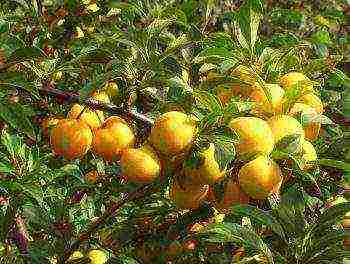
Good neighbors-pollinators for plum Yakhontovaya - Skorospelka krasnaya and Pamyat Timiryazeva.
As can be seen from the table, 4 varieties show the ability to self-fertility. Among them there are two with large fruits of good dessert taste - Kroman 'and Yakhontovaya. Self-fertility in both varieties is partial. This means that they need pollinators for record yields, but even without them, the trees will be able to please with a certain amount of fruit.
Mid-season varieties of plums for growing in the Moscow region
These plums ripen by the end of August or the beginning of September.
| Variety | Early maturity | Self-fertility | Fruit quality |
| Vitebsk late | Fertile for 3-4 years | Yes | On average - 32 g. Fruits are blue with yellow pulp. Taste sweet and sour, tasting rating - 4. |
| Amusing | Fertile for 3 years | No | On average - 16 g. The skin is greenish-orange, the pulp is yellow-green, sweet and sour, the score is 4.1. |
| Kantemirovka | Fertile for 5 years | No | On average - 21 g. The skin is violet-brown, the pulp is juicy, orange, sweet and sour. Score - 4.4. |
| Memory of Timiryazev | Fertile for 3-4 years | Yes | On average - 25 g. The skin is yellow with a pink blush. The pulp is medium juicy, fibrous. The taste is slightly bland, sweet and sour. |
| Kolkhoz renklode | Fertile for 4-5 years | No | On average - 12 g. The skin is thin, greenish-yellow. The pulp is greenish, tender, with a good sweet taste. |
| Smolinka | Fertile for 4-5 years | No | On average - 36 g. The skin is purple, the pulp is yellow, tender. Good dessert, harmonious taste. Rating - 4.8. |
| Sukhanovskaya | Fertile for 4 years | No | On average - 26 g. The skin is greenish-purple, the pulp is yellowish, the score is 4. |
| Morning | Fertile for 6 years | Yes | On average - 26 g. The skin is greenish-yellow, the pulp is yellow, juicy, the score is 4. |
| Purple | Fertile for 4 years | Yes | On average - 21 g. Fruits are oval, with yellow, tender, sweet pulp. Score - 4. |
| Egg blue | Fertile for 5 years | Yes | On average - 29 g. Fruits are violet-blue. The pulp is yellow-green, tender, juicy, of excellent dessert taste. |
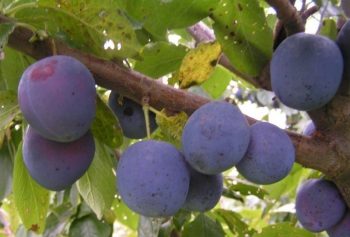
Plum Vitebskaya late shows good resistance to clasterosporium disease, the fruits do not crumble when ripe.
This list contains only five self-fertile varieties. They have approximately the same tasting score, but the largest fruits are in Vitebsk blue and Egg blue. At the same time, the first begins to reproduce 2 years faster.
Late-ripening plum varieties
These plums give off the harvest by mid-September. For the Moscow region, three varieties of late-ripening domestic plums have been zoned: Alexy, Bolkhovchanka and Vengerka Moskovskaya. The largest fruits are in Bolkhovchanka (an average of 34 grams). But this is a self-sterile variety. Alexy and Vengerka of Moscow are capable of self-fertility. INYengerka is very often found in gardens near Moscow, but its fruits are smaller than that of Alexy, the skin is rougher, and the taste is assessed as mediocre.
Thus, the following plum varieties reached the finish line:
- Crooman;
- Yakhontovaya;
- Vitebsk blue;
- Alexy.
Tip # 1. When choosing a seedling in a nursery, it is worth asking which rootstock the variety is grafted on.
For a small plot, trees on low-growing rootstocks are more convenient - they are more compact.For example, VVA-1 (a hybrid of cherry plum and felt cherry) allows growing semi-dwarf plants with high drought and frost resistance.
Planting plum seedlings on the site
Growing any horticultural crop begins with choosing the right site for planting. Plum needs to determine a sunny place, sheltered from drafts: between buildings, behind a low fence, on the southern slope of a slope. Areas with problem soils (with stagnant melt water in spring, with closely located subsoil water horizons, acidified, waterlogged) can destroy the plant. To plant a plum in such a place, you need to take care of its cultivation.
Plum seedlings are usually planted in spring or autumn. For the Moscow region, spring planting is more suitable. Practice shows that due to early frosts, autumn seedlings often do not have time to root normally and die. But it is better to prepare the planting hole in the fall. During the winter, the dug soil will settle in it, and the seedling will not "float" down, maintaining the correct position of the root collar.

When laying in a hole, it is worth adding 2 buckets of manure humus and a liter can of wood ash. The supply of food for the seedling will be enough for the next year.
Plum, like other fruit crops, should be planted using the “on the cone” method. A mound is formed at the bottom of the planting pit, the seedling is placed on its top, and the roots are carefully distributed over the slopes and buried in fertile soil. Before planting, it is useful to treat the roots of the seedling with a rooting stimulator - for example, "Heteroauxin".
Further care of seedlings in the garden
Plum care consists of regular watering, feeding and pruning. Immediately after planting, the seedling begins to form. In a one-year-old, the apical bud is pinched, and in a two-year-old, the central conductor and lateral branches are shortened by a third of the length. Read also the article: → "Ways of forming the crown of fruit trees."
It is not necessary to feed the plant in the first year, but the moisture of the soil should be monitored. It should be normally moist, with no crust on the surface and no stagnant water. To preserve moisture and good air exchange in the upper layers of the soil, mulching the trunk circle is very useful.
Top dressing of plums begins from the second year after planting, they are performed according to the scheme:
- Spring - nitrogen fertilizers. The seedling is given a urea solution (2 tablespoons per 10 liters of water). An adult tree before flowering - a solution of urea and potassium sulfate (2 tablespoons per 10 liters).
- Summer - complex fertilizers. Sapling - nitrophoska in early June (2 tbsp. L. Per 10 l). For an adult tree, when pouring fruits - urea and nitrophoska (2 and 3 tbsp. L. Per 10 l).
- Autumn - forfort-potassium dressing. Sapling - potassium sulfate and superphosphate (2 tablespoons per 10 liters). An adult plant is the same, 2 and 3 tbsp. l. respectively.
Autumn dressing is done after harvest and is part of the planned work to prepare the plant for wintering. Another important procedure is water recharge irrigation. It is performed if the summer was dry. For this, the time is chosen in October, after leaf fall, but before frost. The near-trunk circle is shed to a depth of 2 meters, if the soil is light, and 1 meter on loam.
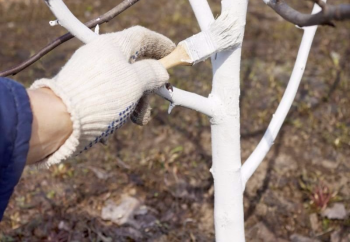
Autumn whitewashing of the trunk will protect the bark of the tree from sunburn and destroy the hibernating larvae of pests.
Popular fertilizers for plums
Today, long-acting fertilizers are very popular, which can be applied once every several years:
- "AVA Universal" or "AVA Elite Gardener" in granules. It is a complete mineral complex. When embedded in soil, it will work for 2-3 years. The survival rate of seedlings increases by 15-25%, and soil fertility increases due to the activation of nitrogen-fixing bacteria.
- APION is an automatic supply osmotic pump. It is also a complex fertilizer with bioregulators, produced in the form of soft balls. The balls themselves are dispensers.Thanks to them, top dressing comes under the roots gradually and only when needed. 4-6 balls are embedded in each trunk circle.
Of the more traditional ones, you should pay attention to the Kemira complex (aka Fertika). reviews of gardeners about Fertik fertilizer.For fruit trees from the line of these fertilizers, you need to choose "Universal-2". There are many good reviews about this product, but you need to carefully observe the dosage. Read also the article: → "Top dressing of trees in spring".
Of the natural, fertilizing based on salts of humic acids works effectively. They are produced by many enterprises. For example, the popular "Barrel and Four Buckets" fertilizer from Fasco. Humic fertilizers can be used both root and leaf. Foliar top dressing "on the leaf" is performed twice per season: in the phases of flowering and filling of fruits.
Tip # 2. Overfeeding a plant is more dangerous than underfeeding it. It is necessary to make top dressing, strictly observing the dosages and terms, otherwise you can destroy not only the tree, but also the soil.
Frequently asked questions from gardeners
Question number 1. I bought a plum sapling, and the blackthorn grew. 3 years of life is down the drain. What to do? Root?
Take your time. Thorn is a good rootstock for plums. You can inoculate several different varieties of plum in the crown and get a "universal soldier" in the garden. The only inconvenience: the blackthorn gives a strong root growth, with which you have to constantly fight.
Question number 2. The plum bears fruit irregularly. Year - thick, year - empty. Is this a variety or something you can do?
Even if the variety is like that, there are a few things you can do. The frequency of fruiting arises from the depletion of the tree with too much yield. Plum is a culture that requires normalizing pruning (shortening of annual shoots) and thinning of the ovaries. If you help a plant to ration its yield, it will begin to bear fruit every year.
Question number 3. Plum varieties Yakhontovaya began to produce 3 years ago, but almost all the fruits are spoiled. First, brown spots appear, and then mold. How to treat?
This is not mold, but moniliosis, another fungal disease. You need to do sanitary pruning: remove all infected branches and burn them. Read also the article: → "Step-by-step instructions for pruning fruit trees: schemes, terms, rules." In the spring, before flowering, treat the tree with Abiga-Peak. Repeat the treatment while pouring the fruit.
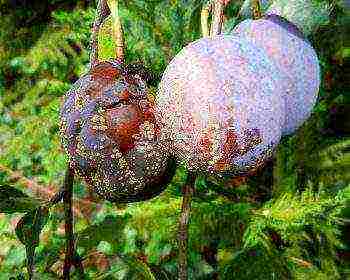
Moniliosis (otherwise "gray rot") is an infectious disease. If left unchecked, the fungus can ruin all the fruit trees in the garden.
Question number 4. Why does the plum blow out and how to deal with it?
In Central Russia, snow often falls on unfrozen soil. In such conditions, under the snow, the bark continues to breathe, and the tissues disintegrate. You can help the plant by compacting (trampling) the snow around the trunk, so that the soil temperature drops as soon as possible.
Question number 5. The plum has set a lot of fruits, but has dropped almost everything. What is the reason?
Perhaps the ovary was broken by a plum sawfly. You need to cut one fruit and see if there is a small white caterpillar in it. If one is found, you will have to shake off all other ovaries from the tree and destroy them. Next spring, before flowering, you need to do the treatment with Metaphos, and after flowering - Tarzan.
It is not difficult to grow a good varietal plum in the Moscow region, and even a novice gardener can do it. It is enough to follow the basic rules: choose zoned varieties, provide for the possibility of pollination and competently care for the plant.
Rate the quality of the article. We want to be better for you:

